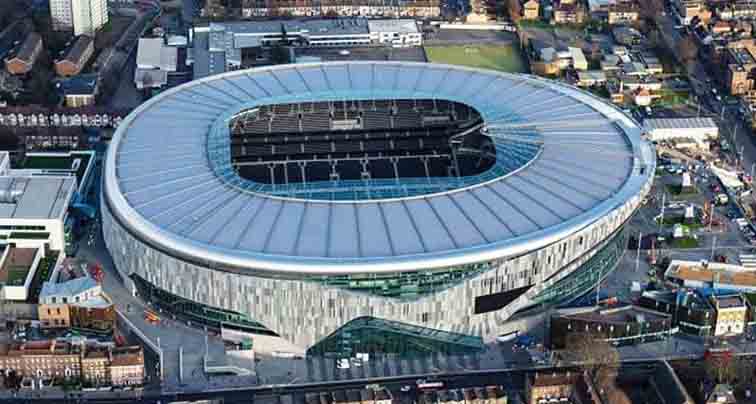Tottenham Hotspur Stadium is the home of North London Premier League club Tottenham Hotspur, replacing the club’s previous ground, White Hart Lane. With a seating capacity of 62,850, it is the third largest football stadium in England and the largest club ground in London.
| Built In: | 2019 |
| Capacity: | 62,850 |
| Home Teams: | Tottenham Hotspur F.C. |
| Ground Size: | 105 by 68 meters |
Tottenham Hotspur Stadium History
Tottenham Hotspur was formed in 1882 and the club’s first games were played on public grounds in the Tottenham Marshes. As their matches became more popular with the public and the number of spectators increased, the club decided to move to an enclosed ground which would allow them to charge an entrance fee and control the crowd.
In 1888 the club leased a field at Asplin’s Farm, next to the railway line in Northumberland Park. However, the ground soon became overcrowded, and in 1899 the club moved to land owned by the Charringtons brewing company to the east of Tottenham High Road, behind the White Hart pub. This became the land of White Hart Lane.
The club acquired the freehold of the ground, as well as additional land at the north end (Paxton Road), in 1905. Starting in 1909, a new stadium with stands designed by Archibald Leitch was built over a period of two and a half decades. . The stadium had a capacity of nearly 80,000 in 1934. Over the years, the stadium underwent a number of changes, with seating replacing standing areas, reducing capacity to around 50,000 by 1979. Significant standing areas still existed, however, including the long fan-favored stretch of raised terrace in the East Stand known as The Shelf.
In the early 1980s, the White Hart Lane ground was redeveloped and, to meet the recommendation of the 1989 Taylor Report, it was converted into an all-seater stadium. The stadium’s capacity was reduced to around 36,000 when the redevelopment was completed in 1998. By this time, the capacity was lower than that of the grounds of other major English clubs, and many of these clubs were also planning to expand further.
With revenue from gate receipts in that period forming a substantial part of the club’s income (before it became dominated by TV broadcast rights deals), Tottenham began to explore ways of increasing the stadium’s capacity to enable it to compete financially more effectively with rival clubs.
Various schemes were considered over the years; these included rebuilding the East Stand as a three-tier structure, and moving to different stadiums and locations such as Picketts Lock and the Olympic Stadium in Stratford, London. None of these plans came to fruition, except for a proposal to redevelop the existing site which was to become the Northumberland Development Project.
Stadium Capacity
The stadium Capacity for this tournament is 62,850.
Tottenham Hotspur Stadium Seating Plan

Notable Events & Records
Our stadium has been designed for multiple uses, including a structurally designed fully retractable pitch, a first for any stadium in the UK, to ensure the football playing surface is always in top condition.
Below the grass field is a synthetic turf surface that can be used for NFL games and other events.
Upcoming Events
N/A
Parking
Tottenham Hotspur Stadium has the very best parking system.

